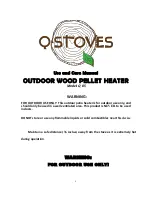
4
HD02 01/10/11
3.1.10
Asbestos
This stove contains no asbestos. If there is a possibility of disturbing any asbestos in the course of
installation then please seek specialist guidance and use appropriate protective equipment.
3.1.11
Metal Parts
When installing or servicing this stove, proper care should be taken to avoid the possibility of personal
injury.
4.0
Installation Information
4.1
Chimney
The chimney height and the position of the chimney terminal should conform to Building Regulations.
Minimum chimney height is 4.5m. Check that the chimney is in good condition, dry, free from cracks and
obstructions. The diameter of the flue should not be less than 150mm and not more than 200mm. If any of
these requirements are not met, the chimney should be lined by a suitable method. The chimney must be
swept before connection to the stove.
Where the chimney is believed to have previously served an open fire installation, it is possible that the
higher flue gas temperature from the stove may loosen deposits that were previously firmly adhered, with
the consequent risk of flue blockage. It is therefore recommended that the chimney be swept a second time
within a month of regular use after installation.
If you have any doubts about the suitability of your chimney, consult your local dealer/stockist or chimney
specialist. If there is no existing chimney then either a solid fuel compatible prefabricated block chimney or
a twin-walled insulated stainless steel flue to BS 4543 can be used. These chimneys must be fitted in
accordance with the manufacturer’s instructions and Building Regulations.
4.2
Ventilation
Purpose provided ventilation is recommended, however, it is not required in England and Wales unless the
appliance rated output is greater than 5kW. Over 5kW 5.5 cm
2
of ventilation (550mm
2
) is required for every
kW output above 5. For example 6.5 kW requires 8.25 cm
2
and 8 kW needs 16.5cm
2
. In any case, if
difficulty in starting the fire or any fuming is experienced, ventilation must be put in place as required to
eliminate these flue problems. If a flue draught stabiliser is fitted then extra ventilation is required – see
Document J of the Building Regulations.
4.3 Flue Draught
A flue draught of minimum 1.2mm to a maximum 2.5mm water gauge (12 to 25 Pascals) is required for
satisfactory appliance performance. The flue draught should be checked under fire at high output and, if it
exceeds the recommended maximum, a draught stabiliser must be fitted so that the rate of burning can be
controlled to prevent over-firing.
4.4 Connection to the Chimney
This appliance is
not
suitable for use in a shared flue. This appliance requires a direct flue connection to the
spigot. If practical, an existing fireplace opening can be bricked up or sealed with a register plate and a short
length of flue pipe of a minimum 150mm internal diameter may then be used to connect the stove to the
register plate in the chimney. This flue pipe should conform to Building Regulations. The stove must be
insulated and properly fitted into the fireplace opening by back filling with 6:1 ratio vermiculite & cement
mixture using minimal water through the top of the fireplace or flue spigot opening. The surface should be
finished using 1:1:8 mix of cement, lime and sand. The connecting pipe is fitted with the spigot pushed up
from
inside
the stove and rotated onto its keyhole slots to join to the pipe. Ensure that the pipe end is no
closer than 76mm to the side or rear chimney walls.
































